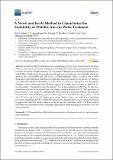| dc.description.abstract | Metallic iron (Fe0) materials have been industrially used for water treatment since the 1850s. There are still many fundamental challenges in affordably and reliably characterizing the Fe0 intrinsic reactivity. From the available methods, the one using Fe0 dissolution in ethylenediaminetetraacetic acid (EDTA—2 mM) was demonstrated the most applicable as it uses only four affordable chemicals: Ascorbic acid, an ascorbate salt, EDTA and 1,10-Phenanthroline (Phen). A careful look at these chemicals reveals that EDTA and Phen are complexing agents for dissolved iron species. Fe3-EDTA is very stable and difficult to destabilize; ascorbic acid is one of the few appropriate reducing agents, therefore. On the other hand, the Fe2-Phen complex is so stable that oxidation by dissolved O2 is not possible. This article positively tests Fe0 (0.1 g) dissolution in 2 mM Phen (50 mL) as a characterization tool for the intrinsic reactivity, using 9 commercial steel wool (Fe0 SW) specimens as probe materials. The results are compared with those obtained by the EDTA method. The apparent iron dissolution rate in EDTA (kEDTA) and in Phen (kPhen) were such that 0.53 ≤ kEDTA (μg h−1) ≤ 4.81 and 0.07 ≤ kPhen (μg h−1) ≤ 1.30. Higher kEDTA values, relative to kPhen, are a reflection of disturbing Fe3 species originating from Fe2 oxidation by dissolved O2 and dissolution of iron corrosion products. It appears that the Phen method considers only the forward dissolution of Fe0. The Phen method is reliable and represents the most affordable approach for characterizing the suitability of Fe0 for water treatment. | en_US |

